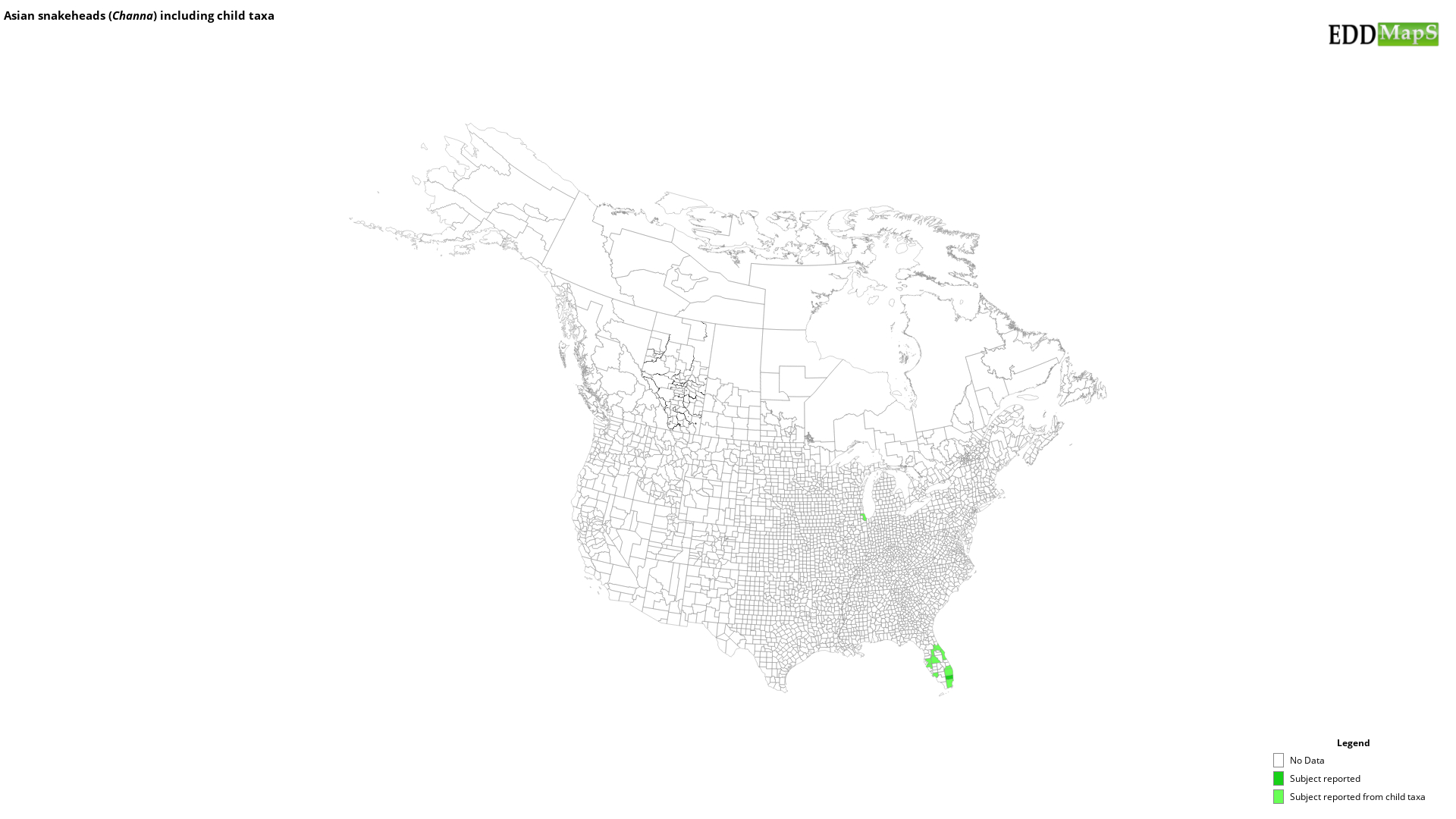Asian snakeheads
(Genus Channa)
This species is Introduced in the United States
Origin
Snakehead are native to tropical Africa and Asia.
Life Cycle
Snakeheads are a taxonomic group of fish species named because their long cylindrical body shape, as well as the presence of large scales (on some species) and location of their eyes on top of their heads. Snakeheads have small heads with large, wide mouths and sharp teeth and are aggressive predators. They have a primitive lung for respiration, which allows them to breathe air and survive out of water for up to 4 days if they stay moist. Snakeheads are generally tan to black in color and patterned with contrasting spots or blotches.
A mating pair builds a circular nest before spawning thousands of buoyant eggs and guard the young until juveniles are able to swim.
Distribution
The family Channidae has been introduced to several eastern states and Oahu, Hawaii. Snakeheads are not established in California. The only confirmed report of snakehead in California was a single northern snakehead (Channa argus) collected from Silverwood Lake in San Bernardino County in 1997.
Control Efforts
Snakehead are not established in California. If you capture one please immediately kill it and report it to the California Department of Fish and Wildlife. California prohibits the importation, transportation, or possession of any live species of family Channidae per C.C.R. Title 14, § 671.
Snakehead are native to tropical Africa and Asia.
Life Cycle
Snakeheads are a taxonomic group of fish species named because their long cylindrical body shape, as well as the presence of large scales (on some species) and location of their eyes on top of their heads. Snakeheads have small heads with large, wide mouths and sharp teeth and are aggressive predators. They have a primitive lung for respiration, which allows them to breathe air and survive out of water for up to 4 days if they stay moist. Snakeheads are generally tan to black in color and patterned with contrasting spots or blotches.
A mating pair builds a circular nest before spawning thousands of buoyant eggs and guard the young until juveniles are able to swim.
Distribution
The family Channidae has been introduced to several eastern states and Oahu, Hawaii. Snakeheads are not established in California. The only confirmed report of snakehead in California was a single northern snakehead (Channa argus) collected from Silverwood Lake in San Bernardino County in 1997.
Control Efforts
Snakehead are not established in California. If you capture one please immediately kill it and report it to the California Department of Fish and Wildlife. California prohibits the importation, transportation, or possession of any live species of family Channidae per C.C.R. Title 14, § 671.
Resources
- Channa micropeltes - Nonindigenous Aquatic Species Database - U.S. Geological Survey
- Channa argus - Nonindigenous Aquatic Species Database - U.S. Geological Survey
- Channa maculata - Nonindigenous Aquatic Species Database - U.S. Geological Survey
- Channa marulius - Nonindigenous Aquatic Species Database - U.S. Geological Survey
Maps
EDDMapS Distribution - This map is incomplete and is based only on current site and county level reports made by experts, herbaria, and literature. For more information, visit www.eddmaps.org
State Lists - This map identifies those states that have this species on their invasive species list or law.
Invasive Listing Sources
- Alberta Fisheries Act
- Delaware Invasive Finfish
- Florida Conditional and Prohibited Non-Native Species Lists
- Idaho Invasive Species Act
- Maryland Invasive Species Council - Invasive Species of Concern in Maryland
- Mid-Atlantic Field Guide to Aquatic Invasive Species
- Virginia Invasive Species Management Plan 2012
Taxonomic Rank
| Domain: Eukarya |
| Kingdom: Animalia |
| Phylum: Chordata |
| Subphylum: Vertebrata |
| Class: Actinopterygii |
| Subclass: Neopterygii |
| Order: Perciformes |
| Family: Channidae |
| Channa |
References
Common Name Reference: Integrated Taxonomic Information System on-line database.
Scientific Name Reference: Integrated Taxonomic Information System on-line database.


